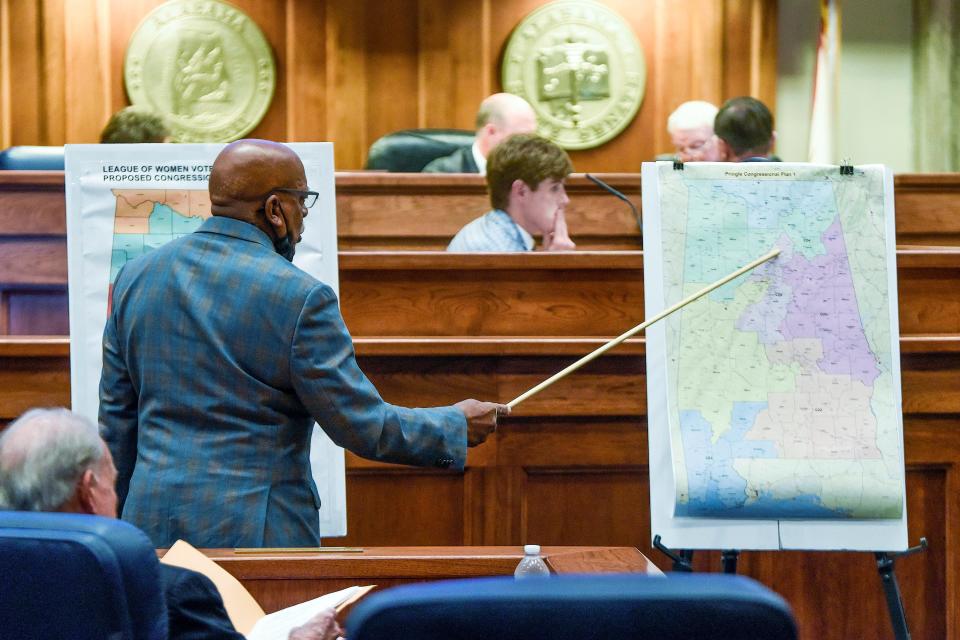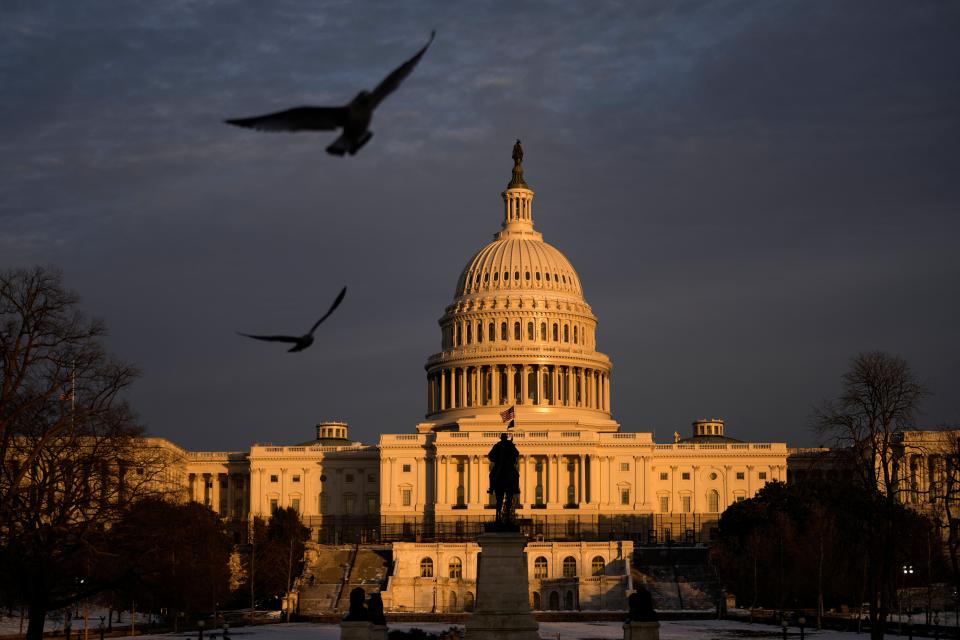New congressional maps constitute 'brazen attack' on voters of color: Report
The ongoing congressional redistricting process "appears to be one of the most abuse laden in U.S. history" in terms of racial discrimination and extreme gerrymandering, according to a Brennan Center for Justice analysis released this month.
Racial and ethnic minority groups, which account for much of the nation's population growth since 2010, won't be fairly represented in a number of states based on maps that have been submitted as part of a reapportionment process that takes place after each decennial census, according to the report. It says many of those districts have been gerrymandered, which means they were divided to give one party unfair advantage in elections.
"Republican map drawers, especially in the South, haven’t just declined to create any new electoral opportunities for these fast-growing communities; in many instances they have dismantled existing districts where communities of color won power or were on the verge of doing so. This brazen attack is unprecedented in scale," according to the report, which sees that effort as undermining the political power of Black, Latino, Asian American and Native American communities ahead of the 2022 midterm vote and other pivotal elections. The Brennan Center describes itself as a nonpartisan law and policy institute.
Related video: Supreme Court decides gerrymandering is not their purview
In such states as Texas, North Carolina and Georgia, map realignments may result in the loss of congressional seats now held by non-white members despite communities of color accounting for most of the population growth, said Michael Li, lead writer of the Brennan report.
Republican-controlled legislatures have drawn lines restricting "opportunity districts," places where a racial or ethnic population is large enough to influence the congressional election, including electing a member of the same group, Li and his co-authors found.

In some cases, Li said, "these maps are going backwards and they are targeting the new, emerging, multiracial America that is taking shape in states like Texas and Georgia."
Major Supreme Court decisions since the last redistricting make it harder to challenge a district map as racially discriminatory, the report states.
The court in 2013 struck down a requirement that certain states with histories of voting restrictions, primarily in the South, submit voting-related changes, including redistricting maps, for preapproval to the Department of Justice. Although racially discriminatory maps are illegal, the court's 2019 decision not to intervene in cases involving partisan gerrymandering makes it easier to disguise racially motivated efforts, the report found.
"In state after state, Republicans are claiming that they are drawing maps on a 'race-blind' basis and then defending the resulting racially discriminatory maps on the basis of partisanship, cynically exploiting the loophole left when the Supreme Court declared that federal courts were off-limits to constitutional challenges to partisan gerrymandering," the report said. "If courts are not willing to carefully probe the intersection of race and politics, the ruse may just succeed."
Removal of the preapproval requirement, known as preclearance, has led some states to avoid "drawing new districts that would help increase representation opportunities for minority communities," said Adam Podowitz-Thomas, senior legal strategist for the Princeton Gerrymandering Project. "I think that if the DOJ were preclearing these maps, a number of states would have been directed to draw additional minority opportunity districts. Because that's not happening, advocates are sort of forced to fight it out in courts later, which is just obviously a much slower and significantly more expensive process."
Many conservatives have disputed allegations that redistricting is aimed at suppressing voters of color, who tend to favor Democrats.
Hans von Spakovsky, senior legal fellow at The Heritage Foundation, doesn't see racial gerrymandering as a significant issue in current redistricting. He disputed the Brennan Center conclusion, saying a district drawn for partisan purposes, which is legal, can resemble one made for racial reasons because voters' political affiliations have become more aligned with their racial identities in many cases.

"The problem today is that it's really difficult to differentiate between politics and race," he said. "If a Democratic legislature wants to draw a district that is going to favor a Democratic candidate and they put a very large African American population in there, are they discriminating on the basis of race or are they putting a large African American population in there because African Americans tend to vote for Democrats 90 to 95% of the time? If a legislator is doing something for political reasons, it's OK. If they're doing it for racial reasons, it's not OK."
Both Republicans and Democrats have engaged in partisan gerrymandering, but Republican-controlled legislatures have an advantage this year, controlling the drawing of 187 congressional districts to just 75 being drawn by legislatures in states under Democratic legislative control, the Brennan Center report said. Independent redistricting commissions draw the lines in a growing number of states, including the most populous one, California.
As of Thursday, 28 states had completed the map-drawing process, although some plans remain subject to litigation. With a wave of congressional primaries scheduled starting in May, there is little time or opportunity available for those seeking changes.
Federal voting rights legislation that would have restricted gerrymandering failed earlier this month in the U.S. Senate, leaving state and federal courts as the primary recourse for map challenges.
An Alabama federal court this week threw out the state's proposed map, saying that Black residents had "less opportunity than other Alabamians to elect the candidates of their choice to Congress." The decision by a three-judge panel, which the state attorney general said will be appealed, calls for a new map to include two districts where Black voters make up at least close to a majority, not just one, as has long been the case.
"It's incredibly significant," said JaTaune Bosby, executive director of the ACLU of Alabama, which represented residents challenging the map. "Based on census data, 27% of the population is Black and we only have 14%, one of the seven congressional districts, that has Black representation. So, the panel essentially said that is unconstitutional."

Suppression of Black voters through redistricting maps and other practices historically "has happened, particularly in the South," and the elimination of the Voting Rights Act's preclearance requirement has made it harder to stop discriminatory practices, Bosby said.
"We are consistently seeing voter suppression take hold in different forms," she said. "And the more that you roll back the (Voting Rights Act), the more challenging it becomes, which is why it's so critical that federal legislation be put in place to secure voting rights for this country."
Heritage's von Spakovsky took issue with the Alabama court's finding, pointing to a section of the Voting Rights Act that says there is no right to elected representation in proportion to a group's population.
Court battles are underway in other states. In December, the Justice Department sued Texas over its new district map, alleging discrimination against Black and Latino voters. Despite Latino arrivals accounting for half of Texas' population growth between 2010 and 2020, the group's voting strength in the state was diluted, the suit says.
"In Texas, Republicans were very aggressive in shoring up their own incumbents by removing minorities who tend to vote Democrat from their districts," said David Wasserman, U.S. House editor for The Cook Political Report, an independent, non-partisan newsletter that analyzes elections and campaigns. "Both of the state's new (congressional) seats are majority white, even though non-whites accounted for 95% of Texas growth."

A challenge to North Carolina's map based on both partisan and racial gerrymandering allegations will be considered by that state's Supreme Court after a trial court upheld the new map. The Brennan Center report says the new North Carolina map, which could shift the Republican congressional advantage from 8-5 to 11-3, eliminates a majority non-white district that has elected a Black member since 1990 by reducing its Black population by 13%.
Although the Supreme Court's decision removes partisan gerrymandering cases from federal dockets, some state courts are considering such cases. The Ohio Supreme Court this month ruled that Republican legislators drew a map that favored that party's congressional candidates.
Still, whatever effect redrawn maps have on minority representation in Congress, the number of people of color seated in the House is likely to grow with the 2022 election, Wasserman said.
"There are going to be more in part because Republicans have placed a great emphasis on recruiting minority candidates," he said. And "Democrats are voting for candidates of color increasingly as well. Even though lines are gerrymandered in some states to minimize the influence of minority voters, the turnover in Congress, because of all of these Democratic retirements and vulnerable Democratic seats, will probably lead to the election of a few more candidates of color."
Gerrymandering, no matter the racial intent, can add an extra layer of disadvantage to "underrepresented groups (that) already have a smaller voice among voters," due to voting and other laws, said Mindy Romero, director of the University of Southern California Center for Inclusive Democracy.

Independent redistricting commissions offer one promising path to fairness in representation, but "the key thing is how independent are they" from political partisanship, Romero said.
"We are in a place where public trust is low in our elected officials, in our political system, in our electoral system," she said. "The idea of an independent commission, I think, can help establish trust."
This article originally appeared on USA TODAY: New congressional districts 'attack' people of color, report finds

